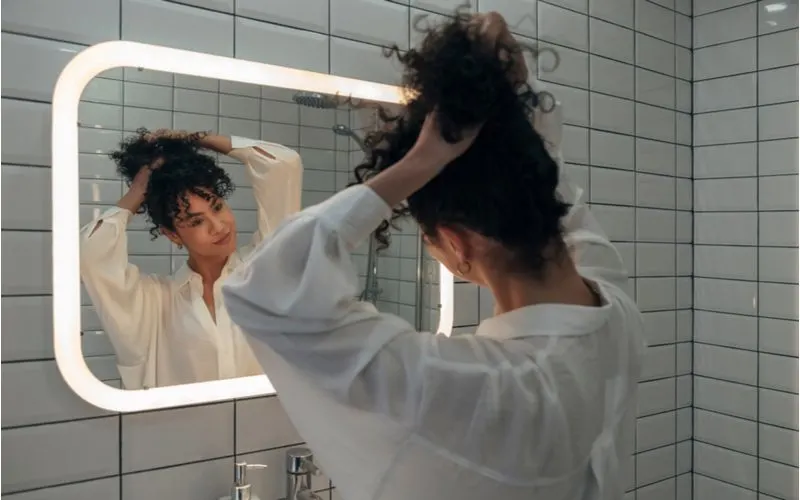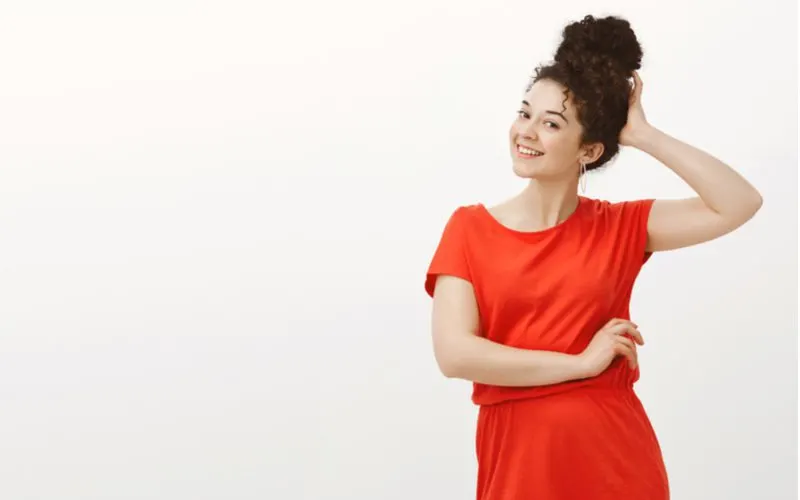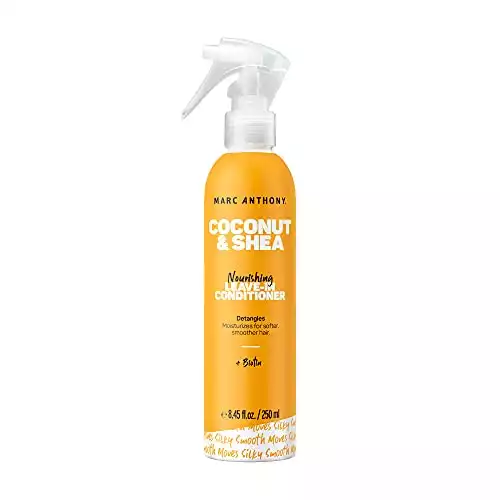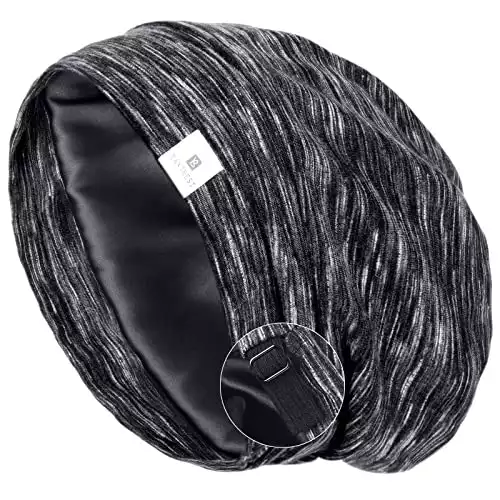Jump to:
If you are part of the curly hair community, you’ve probably heard the term “pineappling.”
This method for protecting your spirals has taken the internet by storm, thanks to its funny name, easy steps, and ability to help you wake up with more beautiful tresses. We’ll teach you how to pineapple hair in our step-by-step guide.
Pineappling Hair: A Summary
Pineappling your hair is incredibly easy, and it requires very little in the way of supplies or time. Yet, it’s one of the most effective ways to protect your silky spirals and wake up to easy-to-manage strands.
- Start with a deep conditioner to add moisture to your curls.
- Flip all your hair upside down by bending forward.
- Gather it all together as close to your forehead as possible.
- Use silk or satin scrunchie to tie off the ponytail.
- Fall asleep on a silk or satin pillowcase.
There are some minor variations to the overall method, depending on the length of your hair. Read on to learn how to pineapple hair for short, medium, and long hair so that you can have springy, shiny locks.
What Is Pineapple Hair?

Daniel Hoz/Shutterstock
The name pineapple hair is inspired by its close resemblance to its namesake fruit. This protective, nighttime style requires that your hair is gathered up on the top of your head, in the same way that a pineapple’s leaves form a crown on top of the tropical treat.
The basic premise of the process is that pillows, sheets, and blankets rub up against curls all night, stealing their moisture and contributing to dry, frizzy ringlets that look flattened after sleeping on them all night.
Pineapple hair seeks to correct that issue by limiting the amount of contact your hair has with the bedding. That means fewer tangles, less frizz, and less frustration during your morning hair routine.
Read Next: How to Get Rid of Frizzy Hair
How to Pineapple Hair in 5 Easy Steps
No matter what the length or texture of your hair, pineappling can help you fight back against flyaways and frizz.
How to Pineapple Long Hair
Long hair needs a little extra TLC to ensure everything is locked in place before you hit the hay. While a ponytail might keep the breakage at bay for shorter styles, your mane needs to be tamed with a headscarf or simply kept in a loose bun instead of a ponytail.
1. Condition and Moisturize
Start by boosting your hair’s hydration with a moisturizing, leave-in conditioner, or intensive hair mask.
For super tight ringlets, we’re fans of Briogeo Farewell Frizz Rosarco Milk Leave-In Conditioner because it prevents humidity from ruining your good hair day. It’s nice and thick, ideal for relieving damaged ends.
If you prefer a spray, Marc Antony Coconut & Shea Nourishing Leave-In Conditioner reverses damage and makes your hair stronger, even if your locks are over-processed. It contains biotin, a protein that your hair matrix needs for a stronger, more resilient curl.
2. Flip Hair and Gather at Your Hairline
Flip your hair upside down so that the underneath is exposed. Pull all of your hair forward, as close to your hairline as possible. It’s okay if a few of your curls break free. You can always secure them later with a scarf or a couple of bobby pins.
3. Secure in a Loose Bun with a Gentle Hair Tie
Pull all of your hair into a loose bun using a silk or satin hair tie. The goal is only to twist the hair tie once to avoid putting indents into your curls, so you may have to experiment a little bit to find the right size.
For ultra-long hair, you can also clip your ends to the side of your head with a couple of large jaw clips. This can take some getting used to, especially if you are a side sleeper, but it will ensure that your luscious locks aren’t left to their own devices overnight.
4. Wrap Your Strands for Added Protection
If you wish to do so, many fans of pineapple hair wrap an oversized silk scarf around their hair to protect the underside and tuck away loose ends. Make sure that you don’t crush your curls underneath the scarf.
The ultimate goal is to wake up with bigger, bouncier curls that are healthy and shiny, and they’ll need a little breathing room to make that happen.
For those long-haired babes who pin clip their curls along the sides of their head, a protective bonnet might work best. Many, like the Yanibest Silk Lined Sleep Cap, are adjustable so that you can achieve the perfect fit.
5. Snooze Away Knowing You’re About to Have a Good Hair Day
When it’s time to hit the hay, do so on satin or silk bedding. It’s less abrasive to curly hair and has long been a favorite solution for those who finally want to conquer their frizz.
How to Pineapple Medium Hair
For medium-length hair, pineappling is the same as the long-hair method. The critical difference is that, instead of stopping just short of completely pulling your hair through the hair tie, you’ll make a loose ponytail.
Once the ponytail is in place, split your curls into two sections and let each fall down to either side of your head. This helps them stay out of the way, instead of rubbing against your pillow all night but doesn’t require you to wear clips to bed.
How to Pineapple Short Hair in 3 Steps
If you’re rocking the short locks, pineappling your hair is effortless! There are two popular strategies for adapting the hair pineapple for short-haired beauties who want to preserve their precious curls:
For bobs and lobs, create multiple pineapples across the top of your head. Start on the left, secure a small hair section, then work your way across to the right. Pin any strays in the back.
You may have to experiment throughout several nights to find the pineapple pattern that best avoids indenting and compressing your curls. Pixie cuts are a cinch, too. Gently gather up the longer hair at your crown into a loose ponytail and tie it off with a curl-safe scrunchie.
Then, with a large hair scarf, wrap the back of your head and draw the ends up. Knot the scarf right behind your “pineapple.” In the morning, your curls will be bouncy on top, while the shorter, textured pieces in the back are tidy.
Things to Consider When Pineappling Hair

Cookie Studio/Shutterstock
Pineappling can change the relationship you have with your hair texture, and it’s hard to get it wrong. Still, before you start the process, keep these tips and tricks in mind:
- Avoid going to bed with wet hair, even if that means washing in the morning instead of in the evening. Wet curls and bedtime don’t mix, as your hair is particularly vulnerable to matting, tangling, breaking, and frizzing when it’s wet.
- When taking your pineapple hair down in the morning, be very gentle and deliberate. Yanking on your hair tie can break off your hair shafts and crimp up your curls. It should be loose enough to come out of your hair quickly, without mashing down your strands as it passes over them.
- For best results, let your hair fall naturally in the morning. Doing so allows your curl pattern to emerge and helps your ringlets last for multiple days. Just remove the scrunchie, give your head a shake from side to side, and gently apply any must-have product to keep those tresses hydrated.
- If all you have on-hand are the classic cotton elastic bands, hold off on pineappling. Curly hair has some pretty intense hold memory, and you may have to completely rewash it to get rid of the indentation of a tight hair tie.
- Skip the pick. You want your curls to be bouncy, shiny, and smooth. Picks compress curls, pulling them out of their natural shape and causing frizziness. Just let the air decompress your post-pineapple tresses for best results.
- If you’ve tried plopping your hair before, use the same hair flipping method for gathering up your curls at your hairline.
- Be kind to yourself and your curls. There’s no doubt that they can be a frustrating texture to work with, but if you are patient and do your research, you will eventually find a method to manage the madness. If pineapple hair isn’t your thing, try another strategy until you’re happy with the results.
Frequently Asked Questions
Why should you pineapple your hair?
You should pineapple curly hair because it is a fast, easy, and effective way to prevent your curls from breaking. In just a matter of seconds, you can save the majority of your hair from rubbing against the rough fabric of your pillow all night.
Can I pineapple wet hair?
While it’s never good to sleep on wet hair, as it loses its elasticity and is more prone to breakage, pineapple is the best alternative to sleeping with it dry. Some people prefer pineapple with wet hair because their curls are bouncier and healthier than when they sleep with dry hair.
How do you make pineapple wavy hair?
You make pineapple wavy hair the same way you would with curly hair! Just flip your head upside down, gather up your hair on a fluffy ponytail, and secure with a silky scrunchie.
How do I make pineapples with longer hair?
Longer curls need to be further secured when using the pineapple method to ensure they stay securely off the pillow at night. Once you’ve got your ponytail, you can either tuck everything into a silk bonnet or pin it back onto the sides of your head with large jaw clips.
Can you pineapple straight hair?
If you have particularly fine, delicate, or frizzy straight hair, pineappling could be the solution you’ve been waiting for. Fine hair, like curls, is an unfortunate victim of nighttime tossing and turning, so the method provides the same protection with no extra steps!
So, How Do You Pineapple Hair?
Pineappling your hair is very easy, and it can be a total game-changer for curly hair. Not only does it help prevent breakage and frizz, but it also promotes the natural shape of your curls and preserves the oils that keep your waves well-hydrated.
Start with completely dry hair to pull off this festive and fruity bedtime routine. Apply your favorite hydrating masks and leave-in conditioners, then gather your strands into a very loose bun or ponytail at your hairline.
Finally, wrap your head in a protective scarf or bonnet before you catch some Z’s.
Check out our curly hair guides to learn more about caring for your unique hair type. Unlock your hair’s potential with our step-by-step guide, How to Activate Curls 8 Ways,” or learn more about your curl type with our Hair Type Chart.



